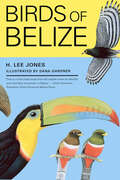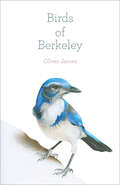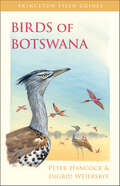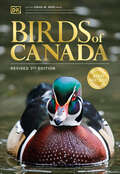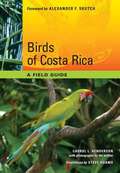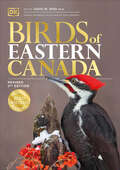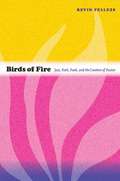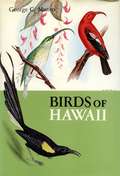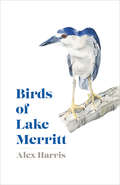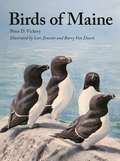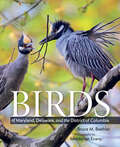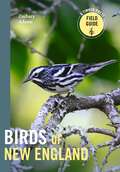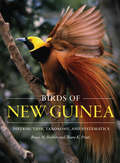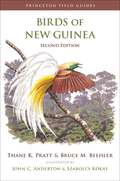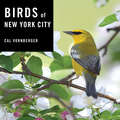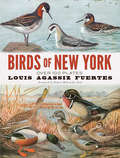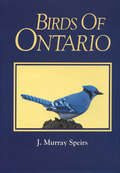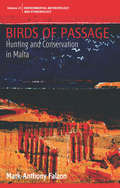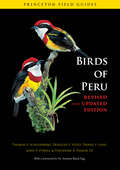- Table View
- List View
Birds of Belize (Corrie Herring Hooks Series)
by Jones H. LeeWith nearly six hundred identified species of birds—and an average of five “new” species discovered annually—Belize is becoming a birding hotspot for amateur and professional birders from around the globe. Thousands of birders visit the country each year to enjoy Belize’s amazing abundance and variety of both temperate and tropical birds in natural habitats that remain largely unspoiled. But until now, despite the growing need for an authoritative identification guide, birders have had to rely on regional field guides that offer only limited information on Belizean birds. Birds of Belize provides the first complete guide to the identification of all currently known species—574 in all. The birds are grouped by families, with an introduction to each family that highlights its uniquely identifying characteristics and behaviors. The species accounts include all the details necessary for field identification: scientific and common names, size, plumage features, thorough voice descriptions, habitat, distribution, and status in Belize. Full color, expertly drawn illustrations by noted bird artist Dana Gardner present male and female, juvenile and adult, and basic and alternate plumages to aid visual identification throughout the year, while 234 range maps show the birds’ distribution and seasonality in Belize. A comprehensive bibliography completes the volume.
Birds of Belize (Corrie Herring Hooks Series)
by H. Lee Jones&“Fills a major gap in the bird identification literature . . . A must for birders planning a trip to this friendly patch of Central America.&” —The Curious Naturalist With nearly six hundred identified species of birds—and an average of five &“new&” species discovered annually—Belize is becoming a birding hotspot for amateur and professional birders from around the globe. Thousands of birders visit the country each year to enjoy Belize&’s amazing abundance and variety of both temperate and tropical birds in natural habitats that remain largely unspoiled. But until now, despite the growing need for an authoritative identification guide, birders have had to rely on regional field guides that offer only limited information on Belizean birds. Birds of Belize provides the first complete guide to the identification of all currently known species—574 in all. The birds are grouped by families, with an introduction to each family that highlights its uniquely identifying characteristics and behaviors. The species accounts include all the details necessary for field identification: scientific and common names, size, plumage features, thorough voice descriptions, habitat, distribution, and status in Belize. Full color, expertly drawn illustrations by noted bird artist Dana Gardner present male and female, juvenile and adult, and basic and alternate plumages to aid visual identification throughout the year, while 234 range maps show the birds&’ distribution and seasonality in Belize. A comprehensive bibliography completes the volume. &“A first-class book that will enable users to identify any bird they encounter in Belize.&” —Victor Emanuel, President, Victor Emanuel Nature Tours
Birds of Berkeley
by Oliver JamesThis charming, full-color field guide to 25 birds easily found in Berkeley proves that even the city's avian residents are a little quirky. Meticulously detailed illustrations capture each bird's distinctive physicality and temperament. A Burrowing Owl faces you in a full-on head shot, perhaps having just raised its raspy, chattering alarm call as you trespass on its last remaining Bay Area foothold at the Marina. The Anna's Hummingbird gives you a coy backward glance to assess if you've properly admired its flashy throat feathers, maybe having just performed its signature J-shaped courtship dive. Even in composition, each bird is strikingly individual, whether depicted in mid-dive or creeping into frame. While descriptions of identification and vocalizations are straightforward, author-illustrator Oliver James takes a delightfully creative approach to his write-ups of each species. He invites you to imagine that a Cooper's Hawk, for example, is Steve McQueen in a '68 Mustang, and you, “a pigeon in a rental car with a poor turning radius,” are fleeing through traffic: “It's all over in a matter of seconds.” A joy to read and pore over, Birds of Berkeley will enchant readers far beyond the city limits with its findings gleaned from painstaking and patient wildlife observation.
Birds of Botswana (Princeton Field Guides)
by Peter Hancock Ingrid WeiersbyeThe definitive field guide to the birds of BotswanaHere is the ultimate field guide to Botswana's stunningly diverse birdlife. Covering all 597 species recorded to date, Birds of Botswana features more than 1,200 superb color illustrations, detailed species accounts, seasonality and breeding bars, and a color distribution map for each species. Drawing on the latest regional and national data, the book highlights the best birding areas in Botswana, provides helpful tips on where and when to see key species, and depicts special races and morphs specific to Botswana. This is the first birding guide written by a Botswana-based ornithologist and the only one dedicated specifically to Botswana.Portable and easy to use, Birds of Botswana is the essential travel companion for anyone visiting this remarkable country.Covers all 597 species of birds found in Botswana, including subspecies and color variants specific to BotswanaFeatures more than 1,200 color illustrations—with more than one illustration for species where the sexes and ages differIncludes detailed species accounts, seasonality and breeding bars, and color distribution mapsDraws on the latest bird data and the expertise of leading birders in Botswana
Birds of Canada
by DKThis photographic guide to the full range of birds found in Canada includes full page profiles of more than 430 of the most commonly seen birds. Each profile is accompanied by diagrams of flight patterns, and photographs showing each featured species in its typical habitat or performing characteristic behaviour. There is a special section highlighting rare species and vagrants as well.
Birds of Costa Rica
by Carrol L. HendersonAt the biological crossroads of the Americas, Costa Rica hosts an astonishing array of plants and animals--over half a million species Ecotourists, birders, and biologists come from around the world, drawn by the likelihood of seeing more than three or four hundred species of birds and other animals during even a short stay. To help all of these visitors, as well as local residents, identify and enjoy the wildlife of Costa Rica, Carrol Henderson published Field Guide to the Wildlife of Costa Rica in 2002, and it became the instant and indispensable guide. Now Henderson has created a dedicated field guide to the birds that travelers are most likely to see, as well as to the unique or endemic species that are of high interest to birders. Birds of Costa Rica covers 310 birds--an increase of 124 species from the earlier volume--with fascinating accounts of the birds' natural history, identification, and behavior gleaned from Henderson's forty years of traveling and birding in Costa Rica. All of the accounts include beautiful photographs of the birds, most of which were taken in the wild by Henderson. There are new updated distribution maps and a detailed appendix that identifies many of the country's best bird-watching locations and lodges, including contact information for trip planning purposes.
Birds of Eastern Canada
by DKIdeal for Canadian birdwatchers and bird lovers of every age! Each of these regional field guides are filled with page after page of magnificent close-up photographs and helpful full-page profiles of hundreds of commonly seen species. With an East / West division made at the 100th meridian (approximately Winnipeg) these handy books offer scientifically accurate and readable accounts of notable characteristics and information everything from behavior and habitat to nest construction and conservation status. Each profile also features diagrams of flight patterns and statistics of size, wingspan and lifespan. These invaluable reference guides are both detailed and accessible, with a user-friendly format that will make it easy for birders to enjoy either studying one species account at a time or browsing to make cross comparisons. + Features over 350 full-colour photographs + Each page includes a notes section for recording bird-watching activities + Both titles include rare birds About the Editor - David M. Bird is Emeritus Professor of Wildlife Biology and former Director of the Avian Science and Conservation Centre at McGill University. As a past president of the Society of Canadian Ornithologists, a director with Bird Studies Canada, and a Fellow of the American Ornithologists&’ Union, he has received several awards for his conservation and education efforts. Dr. Bird is a regular columnist for both Bird Watcher&’s Digest and Canadian Wildlife and is the author of several books and over 200 scientific publications. He is the consultant editor for DK&’s Birds of Canada, Birds of Eastern Canada, Birds of Western Canada, and Pocket Birds of Canada. Visit his website at www.askprofessorbird.com.
Birds of Fire: Jazz, Rock, Funk, and the Creation of Fusion
by Kevin FellezsBirds of Fire brings overdue critical attention to fusion, a musical idiom that emerged as young musicians blended elements of jazz, rock, and funk in the late 1960s and 1970s. At the time, fusion was disparaged by jazz writers and ignored by rock critics. In the years since, it has come to be seen as a commercially driven jazz substyle. Fusion never did coalesce into a genre. In Birds of Fire, Kevin Fellezs contends that hybridity was its reason for being. By mixing different musical and cultural traditions, fusion artists sought to disrupt generic boundaries, cultural hierarchies, and critical assumptions. Interpreting the work of four distinctive fusion artists--Tony Williams, John McLaughlin, Joni Mitchell, and Herbie Hancock--Fellezs highlights the ways that they challenged convention in the 1960s and 1970s. He also considers the extent to which a musician can be taken seriously as an artist across divergent musical traditions. Birds of Fire concludes with a look at the current activities of McLaughlin, Mitchell, and Hancock; Williams's final recordings; and the legacy of the fusion music made by these four pioneering artists.
Birds of Hawaii
by George C. MunroBirds of Hawaii is not a drily scientific text, although it is clearly the product of scientific observation and study. It is enlivened by Mr. Munro's consuming pleasure in his subject and by his introduction of hundreds of interesting sidelights from his lifetime pursuit of knowledge concerning it.The book is divided into three sections: "Native Birds", "Stray Variants to the Hawaiian Islands" and "Imported Birds." Each bird is identified by its scientific name, its common name(or names), and in the case of native birds, by its Hawaiian name. These designations are followed by a description of the bird's essential characteristics, its habitat, its distinctive song or cry, and its habits. The descriptions are enhanced by vivid details from the author's own experience in observing his subjects.Twenty plates in full color, comprising illustrations of more than 150 different species of birds, together with a selection of black and white photographs, provide the reader with an easy means for identification of the birds described.
Birds of Hawaii
by George C. MunroBirds of Hawaii is not a drily scientific text, although it is clearly the product of scientific observation and study. It is enlivened by Mr. Munro's consuming pleasure in his subject and by his introduction of hundreds of interesting sidelights from his lifetime pursuit of knowledge concerning it.The book is divided into three sections: "Native Birds", "Stray Variants to the Hawaiian Islands" and "Imported Birds." Each bird is identified by its scientific name, its common name(or names), and in the case of native birds, by its Hawaiian name. These designations are followed by a description of the bird's essential characteristics, its habitat, its distinctive song or cry, and its habits. The descriptions are enhanced by vivid details from the author's own experience in observing his subjects.Twenty plates in full color, comprising illustrations of more than 150 different species of birds, together with a selection of black and white photographs, provide the reader with an easy means for identification of the birds described.
Birds of Hawaii
by George C. MunroBirds of Hawaii is not a drily scientific text, although it is clearly the product of scientific observation and study. It is enlivened by Mr. Munro's consuming pleasure in his subject and by his introduction of hundreds of interesting sidelights from his lifetime pursuit of knowledge concerning it.The book is divided into three sections: "Native Birds", "Stray Variants to the Hawaiian Islands" and "Imported Birds." Each bird is identified by its scientific name, its common name(or names), and in the case of native birds, by its Hawaiian name. These designations are followed by a description of the bird's essential characteristics, its habitat, its distinctive song or cry, and its habits. The descriptions are enhanced by vivid details from the author's own experience in observing his subjects.Twenty plates in full color, comprising illustrations of more than 150 different species of birds, together with a selection of black and white photographs, provide the reader with an easy means for identification of the birds described.
Birds of Lake Merritt
by Alex HarrisThis charming full-color field guide introduces us to fifteen waterbirds easily found in the urban wildlife refuge of Lake Merritt. In his introduction, author-illustrator Alex Harris includes a history of the lake, providing context for a place that is alluring to humans and shorebirds alike. Each species profile of the lake’s feathered residents is accompanied by a beautiful, detailed watercolor that captures the bird’s distinctive coloring and sinuous physicality. The black-crowned night heron, Oakland’s official city bird, stares with its startling orange eyes, while the American coot flexes its fancy, flared feet. Along with straightforward notes on the identification of each bird, Harris features the voices of Oakland community members, sharing moments of delight from the birds’ most dedicated observers. A celebration of avian life and the human pleasure of witnessing it, Birds of Lake Merritt is an essential guide to the natural world in the heart of the city.
Birds of Maine
by Jeffrey V. Wells Charles Duncan Peter Vickery William J. SheehanA comprehensive and beautifully illustrated overview to the birds of Maine The first comprehensive overview of Maine’s incredibly rich birdlife in more than seven decades, Birds of Maine is a detailed account of all 464 species recorded in the Pine Tree State. It is also a thoroughly researched, accessible portrait of a region undergoing rapid changes, with southern birds pushing north, northern birds expanding south, and once-absent natives like Atlantic Puffins brought back by innovative conservation techniques pioneered in Maine.Written by the late Peter Vickery in cooperation with a team of leading ornithologists, this guide offers a detailed look at the state’s dynamic avifauna—from the Wild Turkey to the Arctic Tern—with information on migration patterns and timing, current status and changes in bird abundance and distribution, and how Maine's geography and shifting climate mold its birdlife. It delves into the conservation status for Maine's birds, as well as the state's unusually textured ornithological history, involving such famous names as John James Audubon and Theodore Roosevelt, and home-grown experts like Cordelia Stanwood and Ralph Palmer. Sidebars explore diverse topics, including the Old Sow whirlpool that draws multitudes of seabirds and the famed Monhegan Island, a mecca for migrant birds.Gorgeously illustrated with watercolors by Lars Jonsson and scores of line drawings by Barry Van Dusen, Birds of Maine is a remarkable guide that birders will rely on for decades to come.
Birds of Maryland, Delaware, and the District of Columbia
by Bruce M. BeehlerMore than 600 lush, stunning photos grace this comprehensive handbook to the birdlife of the Mid-Atlantic region.A Great Blue Heron wades in the shallows of the Potomac River, scanning for unsuspecting prey. Sunlight turns the water translucent as a small school of fish rises to the water's surface. The heron strikes and moments later is swallowing its quarry—predation in action! This handsome Great Blue Heron is but one of the more than 400 bird species found in Delaware, Maryland, and the District of Columbia. It shares the mid-Atlantic with kingfishers, eagles, mergansers, wood warblers, and many more.Exploring backyard birds, birds of prey, and birds of the open ocean, Smithsonian ornithologist Bruce Beehler and premier nature photographer Middleton Evans have crafted a comprehensive volume unparalleled in its beauty and captivating storytelling. Birds of Maryland, Delaware, and the District of Columbia invites readers to experience the birds' lives as they live them: where they nest, how they forage, their various behaviors, and the natural environments they need to survive. Beehler offers practical advice on bird-watching, including how to find, attract, and even garden for birds, as well as the best places to see them in season. He also discusses the best birding apps, websites, and gear; provides advice on planning a birding field trip; and recommends ornithological institutions that will help you cultivate a lifelong birding hobby. Finally, Beehler challenges the reader to think about conservation efforts to preserve local bird populations. With striking color photographs of more than 400 species, this book is a bonanza for nature lovers. A wealth of images immerse the reader in the world of these wonderful creatures. Marvel at the majesty of Ospreys, navigate the ocean with storm-petrels, and nest with Mourning Doves, all while learning about the richness of the birds' lives, the complexities of their habits, and how we can help keep their populations vibrant and aloft for generations to come.
Birds of New England: A Timber Press Field Guide
by Zach AdamsA comprehensive guide to the birds of New England, with stunning photos, maps, and nuanced information on how to locate and identify each unique bird. This easy to use, comprehensive field guide covers the sandy habitats bordered by the Atlantic Ocean to those nestled within vibrant fall foliage, resplendent lakes, and impressive mountain ranges. Birds of New England provides bird aficionados with detailed descriptions of avian voices, behaviors, and habitats, and points out the top birding sites throughout the region. Naturalist and educator Zach Adams provides guidance and helpful tips on all aspects of birding, from equipment to conservation-oriented birding practices, making this a great addition to any bird enthusiast&’s bookshelf. ·Covers Maine, New Hampshire, Vermont, Massachusetts, Rhode Island, and Connecticut ·Describes and illustrates over 350 bird species, including local favorites and rare curiosities ·Over 900 spectacular photographs of relevant plumages and birds in flight ·Individual range maps show each bird&’s seasonal and migratory patterns ·Easy to use for beginners and experts alike
Birds of New Guinea: Distribution, Taxonomy, and Systematics
by Bruce M. Beehler Thane K. PrattNew Guinea, the largest tropical island, supports a spectacular bird fauna characterized by cassowaries, megapodes, pigeons, parrots, kingfishers, and owlet-nightjars, as well as the iconic birds of paradise and bowerbirds. Of the nearly 800 species of birds recorded from New Guinea, more than 350 are found nowhere else on Earth. This comprehensive annotated checklist of distribution, taxonomy, and systematics of the birds of New Guinea is the first formal review of this avifauna since Ernst Mayr's Checklist, published in 1941. This new book brings together all the systematic, taxonomic, and distributional research conducted on the region's bird families over the last 70 years. Bruce Beehler and Thane Pratt provide the scientific foundation for the names, geographic distributions, and systematic arrangement of New Guinea's bird fauna. All technical information is annotated and a geographic gazetteer and bibliography are included. This book is an ideal complement to the Birds of New Guinea field guide also published by Princeton, and is an essential technical reference for all scientific libraries, ornithologists, and those interested in bird classification. The first complete revision of the New Guinea bird fauna since 1941 Accounts for 75 bird species new to the region Includes a geographic gazetteer, bibliography, and explanations of taxonomic and systematic classifications
Birds of New Guinea: Second Edition (Princeton Field Guides #97)
by Bruce M. Beehler Thane K. PrattThe definitive field guide to the marvelous birds of New GuineaThis is the completely revised edition of the essential field guide to the birds of New Guinea. The world's largest tropical island, New Guinea boasts a spectacular avifauna characterized by cassowaries, megapodes, pigeons, parrots, cuckoos, kingfishers, and owlet-nightjars, as well as an exceptionally diverse assemblage of songbirds such as the iconic birds of paradise and bowerbirds. Birds of New Guinea is the only guide to cover all 780 bird species reported in the area, including 366 endemics. Expanding its coverage with 111 vibrant color plates—twice as many as the first edition—and the addition of 635 range maps, the book also contains updated species accounts with new information about identification, voice, habits, and range. A must-have for everyone from ecotourists to field researchers, Birds of New Guinea remains an indispensable guide to the diverse birds of this remarkable region.780 bird species, including 366 found nowhere else111 stunning color plates, twice the number of the first editionExpanded and updated species accounts provide details on identification, voice, habits, and range635 range mapsRevised classification of birds reflects the latest research
Birds of New York City
by Cal VornbergerSee the concrete jungle revealed as a secret habitat for an array of avian life Many marvelous species of bird call New York’s boroughs home, though it takes a keen eye to spot them. Birds of New York City is the culmination of years of work from photographer Cal Vornberger. The product of a master photographer’s patience and ardor, Vornberger’s spectacular images, taken across all five boroughs in all four seasons, reveal an urban environment teeming with wildlife only steps away from speeding cabs and rushing pedestrians. Accompanying these expertly captured images are Vornberger’s engaging anecdotes about his experiences birding in the city, along with helpful photography tips for professionals, hobbyists, or even interested novices, including a detailed list of his trusted equipment. More than two hundred species pass through New York each year, about one-third of the species found in the entire country. With hundreds of dazzling pictures taken year-round and city-wide, Birds of New York City brings these elusive creatures to light for readers everywhere to experience.
Birds of New York: Over 100 Plates
by Louis Agassiz FuertesIn 1910 and 1914, a two-volume study of New York's native birds was issued as part of the State Museum's annual report. A vast catalog of hundreds of species, the survey was illustrated by Louis Agassiz Fuertes (1874–1927), a rising star in scientific bird studies. Fuertes was highly influenced by John James Audubon's The Birds of America, and today he ranks second only to Audubon in terms of output and recognition for ornithological illustration. A frequent lecturer at Cornell University, he honed his expertise during numerous scientific expeditions throughout the United States and abroad, collaborating with Frank Chapman of the American Museum of Natural History on field research, museum dioramas, and book illustrations. This reproduction of all 106 of Fuertes's stunning full-color images spotlights more than 300 birds. It marks the first time that the artwork from Birds of New York has been available in decades, and the volume has never been so affordable. The captions have been reset for easy identification, and a complete Index offers a quick reference. Noted Fuertes expert Robert McCracken Peck provides an informative Foreword. Bird watchers at all levels of experience as well as illustrators, artists, and naturalists will find this book an excellent resource.
Birds of Ontario (Vol #1)
by Robert Bateman J. Murray SpeirsThis extensive and long overdue work of reference covers all of the bird species, more than 400 of which have been recorded in the province of Ontario. Birds of Ontario contains an identification and description of all species, with 344 outstanding colour plates. Anyone with even a casual interest in birds will find the colour plates and informative text of considerable interest. This volume contains a list of all the birds identified in Ontario up to the end of 1983, with the common and scientific names given by the American Ornithologists’ Union 1983 Check-list as arranged in that work.
Birds of Paradise
by Irena HoareHow many different kinds of birds of paradise? Where do birds of paradise live? What colors are birds of paradise? Find the answers to these questions, and learn much more about the physical characteristics, behavior, habitat, and lives of birds of paradise.
Birds of Passage: Hunting and Conservation in Malta (Environmental Anthropology and Ethnobiology #25)
by Mark-Anthony FalzonBird migration between Europe and Africa is a fraught journey, particularly in the Mediterranean, where migratory birds are shot and trapped in large numbers. In Malta, thousands of hunters share a shrinking countryside. They also rub shoulders with a strong bird-protection and conservation lobby. Drawing on years of ethnographic fieldwork, this book traces the complex interactions between hunters, birds and the landscapes they inhabit, as well as the dynamics and politics of bird conservation. Birds of Passage looks at the practice and meaning of hunting in a specific context, and raises broader questions about human-wildlife interactions and the uncertain outcomes of conservation.
Birds of Passage: Hunting and Conservation in Malta (Environmental Anthropology and Ethnobiology #25)
by Mark-Anthony FalzonBird migration between Europe and Africa is a fraught journey, particularly in the Mediterranean, where migratory birds are shot and trapped in large numbers. In Malta, thousands of hunters share a shrinking countryside. They also rub shoulders with a strong bird-protection and conservation lobby. Drawing on years of ethnographic fieldwork, this book traces the complex interactions between hunters, birds and the landscapes they inhabit, as well as the dynamics and politics of bird conservation. Birds of Passage looks at the practice and meaning of hunting in a specific context, and raises broader questions about human-wildlife interactions and the uncertain outcomes of conservation.
Birds of Peru
by Douglas F. Stotz Theodore A. Parker III John P. O'Neill Thomas S. Schulenberg Daniel F. Lane Antonio Brack EggBirds of Peru is the most complete and authoritative field guide to this diverse, neotropical landscape. It features every one of Peru's 1,817 bird species and shows the distinct plumages of each in 307 superb, high-quality color plates. Concise descriptions and color distribution maps are located opposite the plates, making this book much easier to use in the field than standard neotropical field guides. This fully revised paperback edition includes twenty-five additional species.A comprehensive guide to all 1,817 species found in Peru--one fifth of the world's birds--with subspecies, sexes, age classes, and morphs fully illustrated Designed especially for field use, with vivid descriptive information and helpful identification tips opposite color plates Detailed species accounts, including a full-color distribution map Includes 25 additional species not covered in the first edition Features 3 entirely new plates and more than 25 additional illustrations
Birds of Peru
by Dr Antonio Brack Egg Douglas F. Stotz Theodore A. Parker III John P. O'Neill Thomas S. Schulenberg Daniel F. LaneBirds of Peru is the most complete and authoritative field guide to this diverse, neotropical landscape. It features every one of Peru's 1,817 bird species and shows the distinct plumages of each in 307 superb, high-quality color plates. Concise descriptions and color distribution maps are located opposite the plates, making this book much easier to use in the field than standard neotropical field guides. This fully revised paperback edition includes twenty-five additional species. A comprehensive guide to all 1,817 species found in Peru--one fifth of the world's birds--with subspecies, sexes, age classes, and morphs fully illustrated Designed especially for field use, with vivid descriptive information and helpful identification tips opposite color plates Detailed species accounts, including a full-color distribution map Includes 25 additional species not covered in the first edition Features 3 entirely new plates and more than 25 additional illustrations
